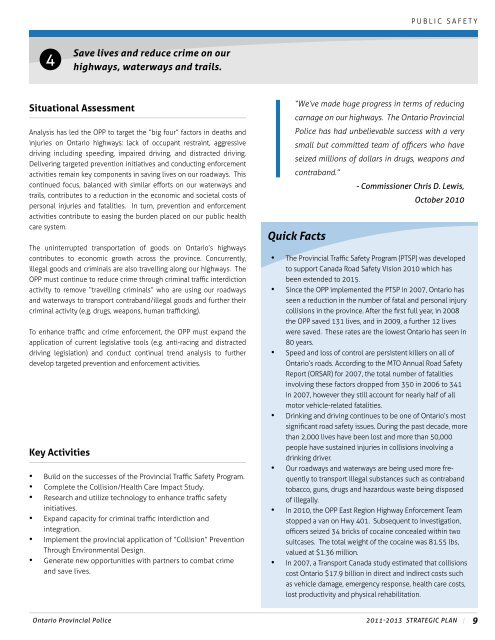OPP Strategic Plan - Police provinciale de l'Ontario
OPP Strategic Plan - Police provinciale de l'Ontario
OPP Strategic Plan - Police provinciale de l'Ontario
You also want an ePaper? Increase the reach of your titles
YUMPU automatically turns print PDFs into web optimized ePapers that Google loves.
4<br />
Save lives and reduce crime on our<br />
highways, waterways and trails.<br />
Situational Assessment<br />
Analysis has led the <strong>OPP</strong> to target the “big four” factors in <strong>de</strong>aths and<br />
injuries on Ontario highways: lack of occupant restraint, aggressive<br />
driving including speeding, impaired driving, and distracted driving.<br />
Delivering targeted prevention initiatives and conducting enforcement<br />
activities remain key components in saving lives on our roadways. This<br />
continued focus, balanced with similar efforts on our waterways and<br />
trails, contributes to a reduction in the economic and societal costs of<br />
personal injuries and fatalities. In turn, prevention and enforcement<br />
activities contribute to easing the bur<strong>de</strong>n placed on our public health<br />
care system.<br />
The uninterrupted transportation of goods on Ontario’s highways<br />
contributes to economic growth across the province. Concurrently,<br />
illegal goods and criminals are also travelling along our highways. The<br />
<strong>OPP</strong> must continue to reduce crime through criminal traffic interdiction<br />
activity to remove “travelling criminals” who are using our roadways<br />
and waterways to transport contraband/illegal goods and further their<br />
criminal activity (e.g. drugs, weapons, human trafficking).<br />
To enhance traffic and crime enforcement, the <strong>OPP</strong> must expand the<br />
application of current legislative tools (e.g. anti-racing and distracted<br />
driving legislation) and conduct continual trend analysis to further<br />
<strong>de</strong>velop targeted prevention and enforcement activities.<br />
Key Activities<br />
•<br />
•<br />
•<br />
•<br />
•<br />
•<br />
Build on the successes of the Provincial Traffic Safety Program.<br />
Complete the Collision/Health Care Impact Study.<br />
Research and utilize technology to enhance traffic safety<br />
initiatives.<br />
Expand capacity for criminal traffic interdiction and<br />
integration.<br />
Implement the provincial application of “Collision” Prevention<br />
Through Environmental Design.<br />
Generate new opportunities with partners to combat crime<br />
and save lives.<br />
Ontario Provincial <strong>Police</strong><br />
Quick Facts<br />
•<br />
•<br />
•<br />
•<br />
•<br />
•<br />
•<br />
PUBLIC SAFETY<br />
“We’ve ma<strong>de</strong> huge progress in terms of reducing<br />
carnage on our highways. The Ontario Provincial<br />
<strong>Police</strong> has had unbelievable success with a very<br />
small but committed team of officers who have<br />
seized millions of dollars in drugs, weapons and<br />
contraband.”<br />
- commissioner chris D. lewis,<br />
October 2010<br />
The Provincial Traffic Safety Program (PTSP) was <strong>de</strong>veloped<br />
to support Canada Road Safety Vision 2010 which has<br />
been exten<strong>de</strong>d to 2015.<br />
Since the <strong>OPP</strong> implemented the PTSP in 2007, Ontario has<br />
seen a reduction in the number of fatal and personal injury<br />
collisions in the province. After the first full year, in 2008<br />
the <strong>OPP</strong> saved 131 lives, and in 2009, a further 12 lives<br />
were saved. These rates are the lowest Ontario has seen in<br />
80 years.<br />
Speed and loss of control are persistent killers on all of<br />
Ontario’s roads. According to the MTO Annual Road Safety<br />
Report (ORSAR) for 2007, the total number of fatalities<br />
involving these factors dropped from 350 in 2006 to 341<br />
in 2007, however they still account for nearly half of all<br />
motor vehicle-related fatalities.<br />
Drinking and driving continues to be one of Ontario’s most<br />
significant road safety issues. During the past <strong>de</strong>ca<strong>de</strong>, more<br />
than 2,000 lives have been lost and more than 50,000<br />
people have sustained injuries in collisions involving a<br />
drinking driver.<br />
Our roadways and waterways are being used more frequently<br />
to transport illegal substances such as contraband<br />
tobacco, guns, drugs and hazardous waste being disposed<br />
of illegally.<br />
In 2010, the <strong>OPP</strong> East Region Highway Enforcement Team<br />
stopped a van on Hwy 401. Subsequent to investigation,<br />
officers seized 34 bricks of cocaine concealed within two<br />
suitcases. The total weight of the cocaine was 81.55 lbs,<br />
valued at $1.36 million.<br />
In 2007, a Transport Canada study estimated that collisions<br />
cost Ontario $17.9 billion in direct and indirect costs such<br />
as vehicle damage, emergency response, health care costs,<br />
lost productivity and physical rehabilitation.<br />
2011-2013 <strong>Strategic</strong> <strong>Plan</strong> | 9



